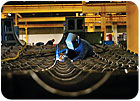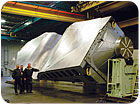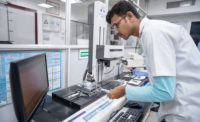
Coast Composites operates a complete metal fabricating shop, including metal bending and welding, in its Santa Ana plant. Source: Siemens
Coast Composites Inc. (Irvine, CA), part of the United Kingdom-based Hampson Industries Plc, is a major supplier of Invar tooling, as well as resin transfer molds and mandrels used in the composite lay-up and manufacture of today’s advanced flight critical aerospace structures. On the large, long bed computer numerical control (CNC) gantry mills used at its main facility in Irvine, CA, the company is achieving an unprecedented accuracy on even the longest wing skins as a result of two complementary technologies that have been combined.
On the largest CNC mill at Coast, a German-built Handtmann five-axis machine that uses twin Siemens (Elk Grove Village, IL) Sinumerik 840D numerical controls, the Siemens volumetric compensation system (VCS) acts in tandem with a proprietary temperature compensation system devised and implemented by Coast engineers. By combining these technologies with ongoing laser calibration, Coast achieves and maintains accuracies to ±0.003 inch on its longest runs. The Handtmann gantry mill can accommodate structures to 22 feet wide by 75 feet long by 84 inches high.
In operation, Siemens VCS factors all the machine kinematics of its various axes of motion, as well as pitch, yaw and roll to precisely adjust the orientation of the tool tip to the work piece. Simultaneously, the Coast temperature compensation system, developed over the company’s years in Invar tooling production for composite parts, further adjusts the machine’s accuracy to compensate the expansion of the machine and the work piece for ambient temperature variations during a 24-hour period. While other companies in the industry typically run such machine tools in a completely air-conditioned environment, Coast Composites has devised its temperature compensation system to overcome these variables in ambient factory conditions and still maintain an accuracy that often exceeds the customer specification, regardless of the material being machined.

Invar tooling and mandrels produced at Coast Composites are used for the production of various commercial and military aircraft. Source: Siemens
Invar tooling is the industry standard for composite lay-up, owing to its low coefficient of thermal expansion, but, as Coast President Paul Walsh explains, “While the material is a high nickel-iron alloy, which gives it great stability, the bottom line is you still get thermal growth over the long distance runs we process. The system we developed was the result of a lengthy analysis on all our long bed machine tools here.”
Coast Composites runs the Handtmann mill at its Irvine facility, as well as Henri Liné five- and six-axis mills, plus SNK and Amura gantry and bridge mills. A 15-year-old Nicolas Correa five-axis gantry mill was recently retrofitted with a new Siemens CNC, motor and drives package, improving both its accuracy and speed, Walsh says.
Jerry Anthony, Coast Composites founder and current director of best practices, adds, “We knew the Siemens volumetric compensation system had substantial merit for our operation when it was first introduced to us, precisely because of the work piece sizes we run and the corresponding thermal growth during machining, even on Invar tools. We had developed our temperature compensation system to adjust the go-to points from the control for real-time temperature on the machine and the work piece.
“The data covered all aspects of our machining, from material composition to acceleration/deceleration mapping and the temperature variations over the largest pieces and longest machine cycles we had performed,” says Anthony.
He notes that Coast Composites runs many grades of aluminum, plus A36, P20, stainless, monolithic graphite, carbon fiber composites and other materials, in addition to Invar 36 and 42. The evolution of tooling materials processed by Coast corresponds to the changes in the aerospace industry, Anthony points out, as the majority of formerly metal parts and structures are now produced by hand lay-up carbon fiber, machine applied carbon reinforced fiber tape, resin infusion processing, filament winding and other manufacturing technologies.
Expanding on the Coast Composites temperature compensation system, Anthony details the on-machine inspection of the work piece and how the Siemens CNC is actually used to complete this process.
“We have used laser tracking in tandem with our Valisys inspection software for some time now, having had a Siemens CNC engineer in Elk Grove Village, IL, write the machine tool inspection interface software for us. In this way, we were and are now still able to use the power of the CNC to run real-time inspections and data analysis that have been extremely useful as an in-process inspection system for any tool manufactured by Coast.”
He muses that the Coast system “essentially turns every machine tool here into its own CMM [coordinate measuring machine].” By developing this system at Coast Composites, Anthony concludes, the laser tracker is now used primarily for final checking, as the in-process monitoring produces what he suggests “might be the highest accuracy machining standard in the aerospace industry.”
Walsh further comments on the evolution of composites in the commercial sector of the aerospace industry and at Coast. “Composites were only being used in non-critical applications but have now emerged on the fuselage, wings, vertical tail and control surfaces to a much greater degree. As one of the earliest players in the commercial composites arena, we have been responding to market conditions quite successfully and continue this trend today.”
Coast Composites supplies tooling for the B777, B787, F-22, F-35, A380, A350 XWB, A320 and other aircraft. On a recent A350 XWB job, the final Coast center wing box section tooling was loaded on an Antonov An-225, the world’s largest aircraft built to date, for transport from Long Beach, CA, to France. This tool is the first tooling delivery for the A350 XWB program.
Siemens Industry Inc.
Drive Technologies - Motion Control (Machine Tool)
Aerospace Center of Competence
(847) 640-1595
www.usa.siemens.com/cnc
Benefits

Coast Composites operates two facilities, one of nearly 80,000 square feet in Irvine, CA, and a new 115,000-square-foot facility in Santa Ana, CA, producing tooling for aircraft structures used by the OEM and primary contractor segments of the aerospace industry. Source: Siemens
How This Marriage Works
In his role as company founder and current director of best practices at Coast Composites, Jerry Anthony has taken great interest in the development of the company’s temperature compensation system, particularly when it was recently “married” to the Siemens volumetric compensation system (VCS). The key point of interface for such a system is within the algorithms of the computer numerical control (CNC), acting to compensate the signal before sending commands to the motors and drives for adaptive action on the machine tool.In a typical long machining cycle on the very large parts produced at Coast, temperature variations in the work piece material combine with the naturally occurring thermal expansion in the machine tool to create serious dimensional issues. This is true for whatever material is being run on the machine, even the Invar high nickel-iron alloy used extensively at Coast for producing composite lay-up tooling, fiber tape mandrels and other structures. While Invar has an extremely low coefficient of thermal expansion, the length of the machine cycle invariably (the word from which Invar got its name) results in sufficient thermal movement of the machine, which adversely affects the tool tip position.
In the Siemens VCS, the CNC compensates for 21 error factors of machine axes, pitch, yaw and roll. The true work piece coordinates, rather than the programmed tool tip position, determine the actual cutting path. In conjunction with the highly advanced Siemens cutter path contouring, this compensation process results in a smoother finish on the part surface and a very high degree of machining accuracy.
In the Coast application, they have further enhanced this process by combining its proprietary temperature compensation system with the VCS inside the CNC to produce a highly accurate cutting path that takes into account the thermal expansion rates for the particular material being run as well as the machine itself.
The standard NC program assumes a 68 F normal operating condition. This would be the norm for a coordinate measuring machine (CMM). The CNC incorporates the Coast temperature compensation system software, while the direct numerical control (DNC) runs the Valisys software, reading off the Renishaw touch probe data from the work piece surface. Thus, the temperature compensation is within the machine control, resulting in real-time adjustments to the machine movement and an overall improved surface finish with superior accuracy, according to Anthony.
“We have run enough material types and enough cycles to develop an impressive data base of averages over time. Our algorithms are the key and, when married to the Siemens power onboard the CNC, result in the old adage that says the whole really is greater than the sum of the parts.”
Siemens Aerospace Center of Competence engineers worked closely with the on-staff engineers at Coast Composites to consummate this marriage and, according to Anthony, the results have been beneficial for both parties.
“The relationship between the Siemens Aerospace Center of Competence and Coast Composites began seven years ago and has progressed to a true partnership, as the two companies have worked together consistently, merging advanced theoretical technologies with experiential knowledge. This has been and continues to be a very dynamic synergy between our companies. Siemens is proud to work with such a leader in the aerospace segment,” according to the Siemens account manager for Coast Composites.
